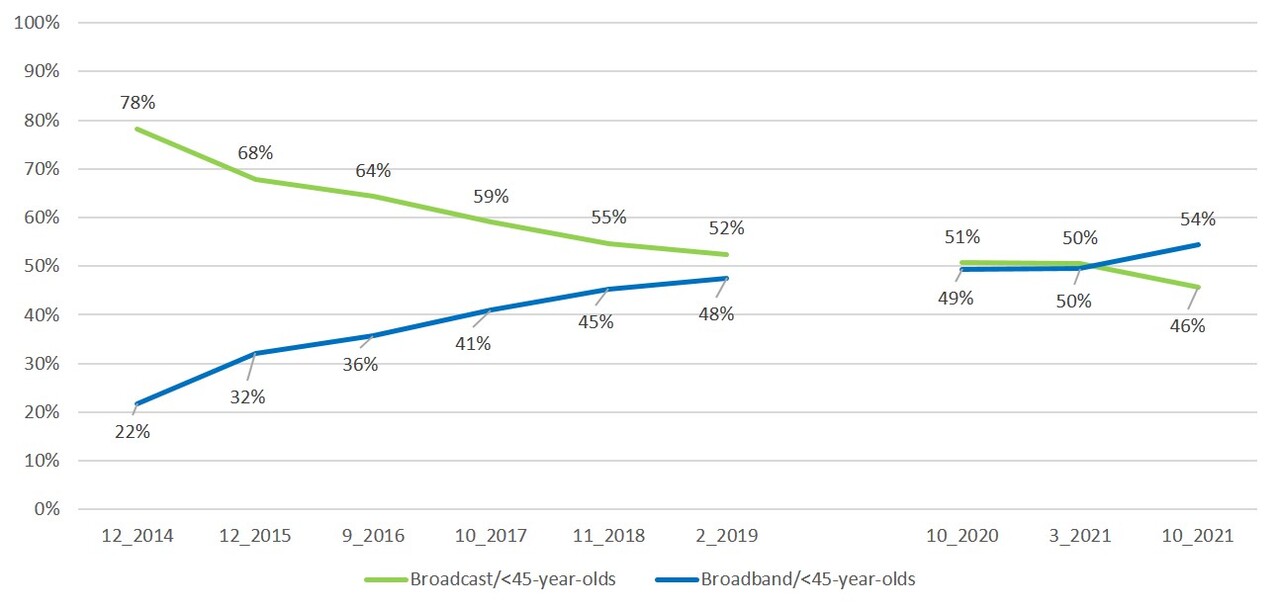More and more Finns have increased their use of internet TV streaming services, reveals a report on TV viewing habits commissioned by the Finnish Transport and Communications Agency Traficom. The change has been contributed to not only by the expanding range of available streaming services, but also the proliferation of smart TVs in households and fast broadband networks enabling smooth video streaming throughout Finland. It is evident that the viewing habits of younger age groups will affect the overall viewing of linear television at the population level over the long term. Traficom is building the preconditions for the alternative distribution of media content by supporting the development of communications networks.
Internet TV streaming services overtook the watching of traditional linear TV among Finns under the age of 45 in 2021, according to the report commissioned by Traficom*. As late as spring last year, total viewing time was still evenly distributed, but by October the share of linear TV had dropped to 46% while the share of streaming services, such as Yle Areena and Netflix, had increased to 54%. In this age group, the watching of linear TV has decreased significantly from 2014, when streaming services accounted for 22% of total TV viewing time.

The change has been less dramatic at the total population level, as the viewing habits of Finns over the age of 45 have not developed in the same way as those of younger age groups. Still, the share of linear TV has decreased from 96% to 88% among Finns over the age of 45. Correspondingly, the share of streaming services had increased from 4% to 12% by October last year. Overall, there is a clear trend visible in the development of viewing time distribution, which the viewing habits of younger age groups will contribute to at the population level over the long term.
Expanding range of services, smart TVs and fast broadband coverage in Finland enable alternative ways of watching TV
The increased use of streaming services has been contributed to not only by the expanding range of available services, but the proliferation of smart TVs in homes as well. The use of streaming services is expected to also increase among older age groups as a result of terrestrial TV networks transitioning to high-definition (HD) broadcasts in the coming years. Nearly all new TVs sold in Finland today are so-called smart TVs that can also be connected to the internet and used to watch several streaming services. New smart TVs also include HD tuners, which are required to watch TV broadcasts after the HD transition.
In addition to the factors related to devices and the range of available services mentioned above, the increasing use of streaming services has also been contributed to by Finland’s extensive and high-quality communications networks. At the start of 2021, approximately 65% of Finns had access to a fixed broadband network enabling download speeds of at least 100 Mbit/s. At the same time, 40% of Finns had access to a fibre-optic network. Correspondingly, the coverage of 4G mobile networks enabling download speeds of 100 Mbit/s was 93% at the end of September 2021, whereas the coverage of 5G networks was 78%. In mobile networks, these top speeds can only be achieved under ideal conditions, whereas actual speeds at any given time are affected by factors such as the number of concurrent users and the user’s distance to the base station. In cities and population centres, telecommunications operators have also started offering fixed wireless connections based on 5G technology.
The Finnish Transport and Communications Agency Traficom promotes
- the HDTV transition by serving as the coordinator of the transition to DVB-T2 transmission technology in terrestrial TV; DVB-T2 transmission technology makes more efficient use of radio frequencies and enables the viewing of HD channels in terrestrial TV households as well
- the proliferation of broadband networks by assigning radio frequencies to new 5G networks and allocating funding for the building of fast broadband networks in areas where their commercial supply will not be possible in the coming years.
With these efforts, we create the preconditions for the alternative distribution of media content.
Report on TV viewing habits (External link) (PDF, 622.91 kB) (in Finnish)
*The results are from a report commissioned by the Finnish Transport and Communications Agency Traficom for which the shares of TV content viewing methods were measured during specific measuring periods from December 2014 to October 2021. For the report, Finnpanel Oy drew on data collected for its TV Audience Measurement, TotalTV Measurement and the National Radio Survey.
Enquiries
Tiina Aaltonen, Senior Specialist, tel. +358 29 539 0526, tiina.aaltonen@traficom.fi
Suvi Juurakko-Lehikoinen, Head of Services, tel. +358 29 539 0446, suvi-juurakko-lehikoinen@traficom.fi, twitter: @l_suvi (External link)